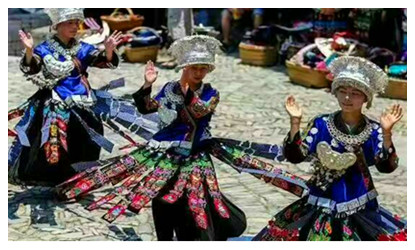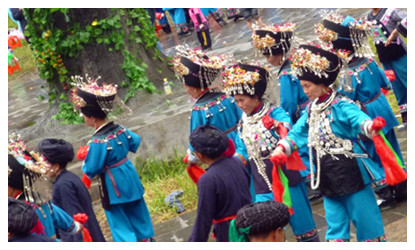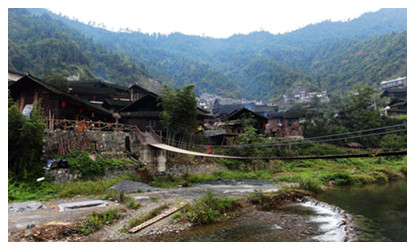Skype: neodalle-travel
Tel: +86 135 7447 2266
E-mail: sales@zhangjiajieholiday.com

The Miao dialect belongs to the Miao-Yao Austronesian of the Chinese-Tibetan Phylum. It has three main dialects in China - one based in west Hunan, one in east Guizhou, and the other in Sichuan, Yunnan, and part of Guizhou. The Miao people once had their own written characters, but these have been long lost. After 1956, the Miao people invented a kind of phonetic characters. Due to their centuries of contact with the Han Chinese, many Miaos can also speak Chinese.
The wide distribution of the Miaos, and the influence of the different environments in which they live, have resulted in marked differences in the dialects and names they use, and in the clothing they wear. Because of these different costums, the Miaos can be divided into the Long Skirt Miao, Short Skirt Miao, Red Miao, Black Miao, etc.
Miao People in Hunan
Miao ethnic minority has a population of more than 1.9 million in Hunan Province, scattered throughout Huayuan, Fenghuang, Jishou, Baojing, Guzhang, Luxi of Tujia, Miao Autonomous State (in west Hunan), Chengbu Miao Autonomous County, Suining (in Shaoyang City), Miao Autonomous County of Maying, Miao and Dong Autonomous County of Jingzhou, Huitong, and Yuanling (in Huaihua).
Living Quarters of Miao
The local Miao peoples build their villages beside rivers and on mountains. The world's largest Miao village comprises 1000 households. Most, however, are much smaller. Often, a village is a tight-knit community made up of twenty or thirty families, all belonging to the same clan, and most of whom are farmers or fishermen. They're quite self-sufficient, from growing their own food to building their own homes. Miao-style houses are wooden and high above group the hilly terrain. Everything there is in balance with nature.
Food of Miao
The Miaos engaged in agriculture, and hunt and fish as a sideline. Major crops include paddy rice, maize, rape, ramie, oil-tea camellia, tung tree, etc. The weather in the areas they inhabit is mild, with a generous rainfall, and the areas are also rich in precious, medical herbs, such as Tianqi, Gastrodia elata, etc.
Customs of Miao
Wizards (witch doctors) are everywhere. There is one for almost every village. It is these who manage religious ceremonies for specific events (e.g., funeral and wedding). Miao people worship nature, totems and ancestors. Miao people believe every natural thing has its manito, but they worship the Dragon most. This is similar to most other Chinese, ethnic groups, including the Han and Tujia. Other nature gods include the Kitchen Range God, the Land God, etc. In western Hunan, Panhu is the Totem of the Miao, because Miao people believe they are the offspring of Panhu. There are Panhu temples (simple ones) in many villages, and people commemorate the Panhu with lavish, outdoor entertainment, at year end. Miao People also do the same with their common ancestors and family ancestors. During any of these events, Miao people will dance and sing.
Festivals of Miao
The Miaos have the New Year Festival, the Flower Mountain Festival (May 5th), the Tasting New Rice Festival (between June and July), and the Tea Picking Festivals, etc. People of the Miao ethnic group perform a folk dance to celebrate their "Sisters Festival" on Sunday. Sisters Festival, which falls on March 15th every year in China's lunar calendar, is a traditional festival of the Miao ethnic group, and boys and girls choose their lovers on that day.
Folk Culture and Art of Miao
The Miaos have created a variety of colorful arts and crafts, including cross-stitch work, embroidery, weaving, batik, and paper-cut. Their batik technique dates back to 1,000 years ago. A pattern is first drawn on white cloth, with a knife dipped in hot wax. Then the cloth is boiled in dye. The wax melts, leaving a white pattern on a blue background. In recent years, improved technology has made it possible to print more colorful designs, and many Miao handicrafts are now exported.
Specific cultural markers that set the Miao apart from other Chinese ethnic groups are their own unique dancing and singing. The Miaos are fond of singing and dancing, being especially famous for their love songs and wine songs. Lusheng is their favorite musical instrument. In addition, flutes, copper drum, mouth organs, Xiao (a vertical bamboo flute), and Suona horn are also very popular.
Miao Villages to visit
 |
 |
 |
| Dehang Miao Village | Shanjiang Miao Village | Hangwu Miao Village |
 Ask Questions ?
Ask Questions ?